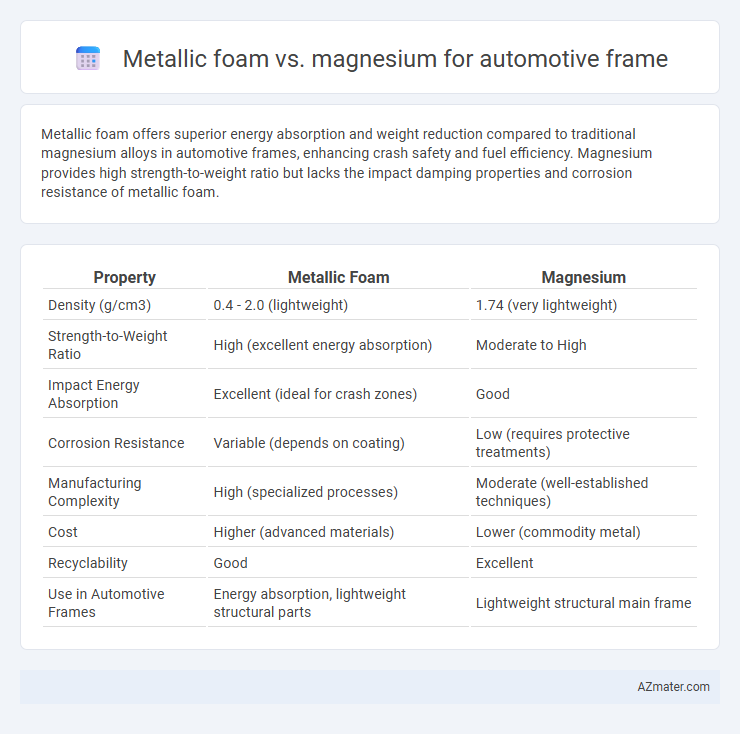Metallic foam offers superior energy absorption and weight reduction compared to traditional magnesium alloys in automotive frames, enhancing crash safety and fuel efficiency. Magnesium provides high strength-to-weight ratio but lacks the impact damping properties and corrosion resistance of metallic foam.
Table of Comparison
| Property | Metallic Foam | Magnesium |
|---|---|---|
| Density (g/cm3) | 0.4 - 2.0 (lightweight) | 1.74 (very lightweight) |
| Strength-to-Weight Ratio | High (excellent energy absorption) | Moderate to High |
| Impact Energy Absorption | Excellent (ideal for crash zones) | Good |
| Corrosion Resistance | Variable (depends on coating) | Low (requires protective treatments) |
| Manufacturing Complexity | High (specialized processes) | Moderate (well-established techniques) |
| Cost | Higher (advanced materials) | Lower (commodity metal) |
| Recyclability | Good | Excellent |
| Use in Automotive Frames | Energy absorption, lightweight structural parts | Lightweight structural main frame |
Introduction to Lightweight Materials in Automotive Frames
Metallic foam offers high strength-to-weight ratio and excellent energy absorption, making it a promising lightweight material for automotive frames compared to traditional magnesium alloys. Magnesium provides low density and favorable stiffness but lacks the superior impact resistance and crashworthiness of metallic foam. Combining these materials in automotive frame design enhances vehicle safety and fuel efficiency by reducing overall weight without compromising structural integrity.
Overview of Metallic Foam and Magnesium
Metallic foam, characterized by its lightweight cellular structure and high energy absorption, offers excellent crashworthiness and thermal insulation for automotive frames. Magnesium, known as one of the lightest structural metals, provides high strength-to-weight ratio and good machinability but suffers from corrosion susceptibility. Both materials contribute to vehicle weight reduction and improved fuel efficiency, yet metallic foam excels in impact resistance while magnesium offers superior rigidity and ease of manufacturing.
Structural Properties: Metallic Foam vs Magnesium
Metallic foam offers superior energy absorption and crashworthiness compared to magnesium, making it ideal for automotive frames requiring high impact resistance. Magnesium provides excellent strength-to-weight ratio but lacks the porous structure that enhances metallic foam's stiffness and vibration damping. The choice between metallic foam and magnesium depends on balancing lightweight performance with desired structural resilience in automotive frame design.
Crashworthiness and Safety Performance
Metallic foam offers superior energy absorption and impact resistance compared to solid magnesium, enhancing crashworthiness in automotive frames by effectively dissipating collision forces. Magnesium provides excellent strength-to-weight ratio but lacks the deformation capacity of metallic foam, potentially resulting in less efficient energy absorption during crashes. Integrating metallic foam into magnesium frames can improve overall safety performance by combining lightweight properties with enhanced crash energy management.
Corrosion Resistance and Durability
Metallic foam, characterized by its porous structure, exhibits superior energy absorption but typically suffers from lower corrosion resistance compared to magnesium alloys, which form a protective oxide layer enhancing durability. Magnesium offers better overall corrosion resistance when treated with advanced coatings, making it more suitable for long-term automotive frame applications prone to environmental exposure. The durability of magnesium frames, coupled with corrosion protection technologies, often surpasses that of untreated metallic foam, providing extended lifespan and structural integrity in automotive frames.
Manufacturing Processes and Scalability
Metallic foam manufacturing for automotive frames involves processes like powder metallurgy, investment casting, and infiltration methods, which allow complex geometries and lightweight structures but often face scalability challenges due to production time and cost. Magnesium framing uses die casting and extrusion techniques, offering high scalability with faster cycle times and established mass-production infrastructure, making it more economically viable for large-scale automotive manufacturing. The scalability of magnesium processes currently surpasses metallic foam, although advancements in metallic foam production methods could enhance its future applicability in automotive frames.
Cost Comparison and Economic Feasibility
Metallic foam offers lightweight benefits with moderate material costs, but manufacturing expenses remain high due to complex production processes. Magnesium presents lower raw material costs and established fabrication techniques, making it economically more feasible for large-scale automotive frame production. Cost efficiency balances with performance requirements, positioning magnesium as the preferred choice for budget-conscious manufacturers aiming for lightweight vehicle structures.
Environmental Impact and Sustainability
Metallic foam offers significant environmental advantages over traditional magnesium for automotive frames due to its lightweight structure, which reduces vehicle mass and improves fuel efficiency, leading to lower CO2 emissions throughout the vehicle's lifecycle. Magnesium production involves high energy consumption and challenging recycling processes, whereas metallic foam primarily utilizes recyclable aluminum or steel, enhancing sustainability by facilitating material recovery and reuse. The enhanced crash absorption of metallic foam also contributes to the longevity and safety of vehicles, promoting sustainable design by extending vehicle lifespan and reducing the need for frequent replacements.
Application Suitability in Modern Vehicles
Metallic foam offers superior energy absorption and crashworthiness, making it ideal for impact zones in automotive frames, while magnesium provides lightweight strength critical for overall vehicle weight reduction and fuel efficiency. The porous structure of metallic foam enhances sound insulation and vibration damping, beneficial for passenger comfort, whereas magnesium's high strength-to-weight ratio supports structural components requiring rigidity and durability. Modern vehicles increasingly integrate both materials, leveraging metallic foam in safety-critical areas and magnesium in load-bearing frame sections to optimize performance and sustainability.
Future Trends in Automotive Frame Materials
Metallic foam offers lightweight structure and excellent energy absorption, enhancing crash safety and fuel efficiency in automotive frames. Magnesium, favored for its superior strength-to-weight ratio and recyclability, supports sustainability goals in next-generation vehicles. Future trends emphasize hybrid material designs combining metallic foam with magnesium alloys to optimize durability, weight reduction, and environmental impact in automotive frame manufacturing.

Infographic: Metallic foam vs Magnesium for Automotive frame
 azmater.com
azmater.com